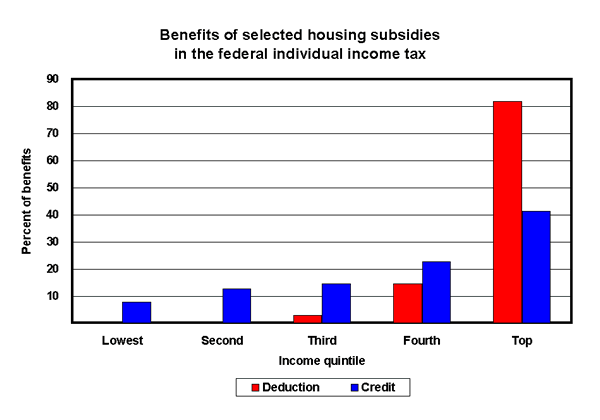See Snapshots Archive.
Snapshot for November 21, 2005.
Rethinking the tax benefits for homeowners
The recommendations of the president’s Advisory Panel on Tax Reform seem to have gone down faster than the Titanic, but the issues raised in its report will persist: federal budget deficits are on an unsustainable course; the need for tax increases will be inescapable; and broadening the base of the income tax will be necessary.
There are two basic ways to broaden the tax base, either eliminate or scale back deductions, or reduce the preferences granted to investment income—chiefly capital gains, dividends, and assorted tax-advantaged savings vehicles such as individual retirement accounts and employer-paid pensions. This Economic Snapshot examines the effects of the home mortgage interest deduction.
Under present law, the homeowner who itemizes deductions can deduct interest paid on a mortgage for first and second homes up to a loan value of $1 million. Such homeowners can also deduct interest on home equity loans up to $100,000.
The advisory panel proposed to convert the deduction into a credit, make it available to all taxpayers (not just those who itemize deductions), limit it to the primary residence, and cap its value according to regional real estate prices. Each change would make the individual income tax more progressive.
Any deduction, as opposed to a credit, is more valuable the higher one’s income and tax bracket. Consider two homeowners who each have $10,000 of mortgage interest, one in the 15% bracket, the other in the 35% bracket. The interest offsets $10,000 of taxable income for each, but the tax savings are $3,500 for the higher-income person and only $1,500 for the lower-income person.
There are several other ways in which these deductions favor the wealthy. Higher-income persons are likely to carry a bigger mortgage and have more interest to deduct, widening the gap further. Higher-income persons also are able to obtain mortgages at higher loan-to-value ratios because they are better credit risks. They can increase tax-deductible interest on the home and invest more in tax-preferred savings. It is also possible to use home equity loans for tax-advantaged investing. Finally, the lower-income person is less likely to have enough deductions to even be able to itemize and claim the deduction.
Research by Carasso, Steuerle, and Bell (2005) finds that the tax benefits mortgage interest and property tax deductions combined rises steeply for incomes in excess of $25,000. They calculate the impact of converting the mortgage interest deduction into a credit in “revenue-neutral” terms. In other words, the government raises no extra tax revenue. The value of their hypothetical credit is 1% of the house value, up to $1,030. The chart below compares the current tax structure with this proposal.

The red bars show the distribution of benefits under the current deductions for mortgage interest and residential property tax. These benefits are invisible for the bottom 40% of taxpayers (much less for those with too little income to file under the income tax), and rise sharply thereafter. By converting one of the deductions into a credit, overall benefits (shown by the blue bars) are more evenly distributed. Such a change would raise taxes for 16% of taxpayers—nearly all in the top 40% of taxpayers—and reduce taxes for 49%.
Source
Carasso, Adam, C. Eugene Steuerle, and Elizabeth Bell, “How to Better Encourage Homeownership,” Tax Policy Issues and Options, Urban-Brookings Tax Policy Center, No. 12, June 2005.
This week’s Snapshot was written by EPI economist Max B. Sawicky.
